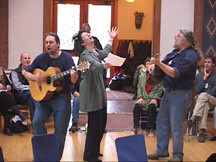 Throughout the year I’m involved in quite a few conferences and meetings. This year, the ground is shifting. Travel budgets are being slashed (faster here than in Europe as far as I can tell) and people are starting to think more seriously about the non financial costs such as carbon emissions of the travel and the plain old wear and tear on our bodies traveling across time zones and geography.
Throughout the year I’m involved in quite a few conferences and meetings. This year, the ground is shifting. Travel budgets are being slashed (faster here than in Europe as far as I can tell) and people are starting to think more seriously about the non financial costs such as carbon emissions of the travel and the plain old wear and tear on our bodies traveling across time zones and geography.
Financially, meeting organizers have serious concerns. One US based conference coming up this Fall is seeing a 30% reduction in registrations and they feel LUCKY! One of my core communities of practice, KM4Dev, just had a call to discuss how we could meet, and scuttle our more ambitious S. Africa plan and do something more focused and less expensive because we could not get funding. Ed-Media, a conference I’ve been invited to speak at (in Hawaii – and yes, I feel both thrilled and carbon-guilty, even with offsets), sent email today announcing opening of virtual presentation submissions and participation. I say “good on ya!” Here are a few snippets from their note:
>> Virtual Presentations included in Final Call <<
http://www.aace.org/conf/edmedia/VP/
> Please forward to a colleague <
http://www.aace.org/conf/edmedia/call.htm
_______________________________________________________________
ED-MEDIA 2009World Conference on Educational Multimedia, Hypermedia & Telecommunications
June 22-26, 2009 * Honolulu, HawaiiINVITATION:
ED-MEDIA 2009 serves as a multi-disciplinary forum for the discussion and exchange of information on the research, development, and applications on all topics related to multimedia and telecommunications/distance education.ED-MEDIA, the premiere international conference in the field, spans all disciplines and levels of education and attracts more than 1,500 attendees from over 60 countries. We invite you to attend ED-MEDIA and submit proposals for presentations.
All presentation proposals are peer-reviewed and selected by three reviewers on the respected Program Committee for inclusion in the conference program, Proceedings (book and CD-ROM formats) and EdITLib (Education and Information Technology Digital Library), http://www.EdITLib.org
VIRTUAL PRESENTATIONS:
————————————-In consideration of presenters who may be unable to attend ED-MEDIA in person due to funding or time constraints, Virtual Presentations have been added to the program with the same validity (publication, certification, etc.) as the face-to-face (F2F) conference and with the capability to interact with session participants.
A limited number of presentations in these categories will be accepted:
– Virtual Brief Papers
– Virtual Posters
– Virtual Corporate ShowcasesWhy a Virtual Presentation?
————————————
* Saves money. No travel, accommodation, and restaurant costs
* Saves time. No travel or away time required.
* Allows you to participate when you schedule your time to do so.
* Same validity as the face-to-face (F2F) conference (publication, certification, etc.).
* Paper published in CD, book, and Digital Library ( http://www.editlib.org) proceedings.
* Publish and share all supporting media (PPT, video, etc.) in the proceedings.
* Capability to interact with your session
I love meeting face to face. But the reality is those of us who can are priveledged and soon, the ability to travel and gather may be even more restricted. We have to get better at “being together” using technology. That means better tools AND practices. That probably leads me to griping about the web meeting tools I have been using because they are what my clients use.
After criticizing SharePoint last week for it’s silo-creating, I have to ding Microsoft Live Meeting for it’s top down control model. There is no group chat (participants can only chat with the moderator or one other person at a time, thus no horizontal communication nor any easy ability to collectively take notes), there is no visible participant list (thus defeating any community building part of one’s agenda), and there can only be one moderator at a time, reducing the ability to agily collaborate. This is “I deliver content to you” style technology. Yes, it may integrate nicely with Office and Outlook, but what if you are not using or don’t focus on these integration issues?
Not far behind in its clunkiness is WebEx, which makes passing the control baton something of a high wire act. I have enjoyed using Elluninate more. I’ve had the best luck with their integrated VoIP and their breakout rooms, while still a bit tricky, are much easier for me than WebEx.
On the free and lower cost side, Vyew is getting higher marks from me, but I’ve not tested it with a larger group and have not taken a run at the latest version of Dim Dim. Both currently offer 20 person rooms for free!
Skype – audio and chat – is still at the core of my small group meetings, often augmented by a quality phone/Skype bridge when I have larger groups (which costs me $40/month).
However, without clear purpose and useful practices, these tools are useless. We need to make gathering time serve our purposes and to be useful, functional and ENJOYABLE. Not a torture test. Friends and colleagues in my circle have all acknowledged we need to start thinking, working and practicing together to both better understand and manipulate the tools and improve the meeting processes themselves. Clearly, I need to make time for this.
Photo credit (and yes, I’ve used this one twice!) by stephentrepreneur
 Simply worth quoting….
Simply worth quoting….
 The word “tinkering” keeps coming up to my radar screen, and it makes me happy. I love the idea of tinkering and find it central to the practice of
The word “tinkering” keeps coming up to my radar screen, and it makes me happy. I love the idea of tinkering and find it central to the practice of  Alex Soojung-Kim Pang
Alex Soojung-Kim Pang 
